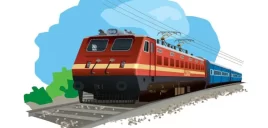IR has only recently [3/06] begun running a few double-stacked container trains. This is primarily because most of IR’s main routes are electrified and raising OHE clearances is not permitted under the present Schedule Of (moving) Dimensions. (But see below.) Other reasons include low axle loads permitted on certain lines and types of wagons (20.32 tonnes on most lines and for most wagons, and 22.9 tonnes for few routes and type of wagons).
RDSO has been exploring the possibilities for double-stacking and some trials have been run. Normally, BLCA and BLCB flat wagons used for 9.5′ high containers have 840mm diameter wheels with a floor heigh tof 1009mm above the rails. A single rake (45 BLCA/BLCB) can carry 90 20′ long ISO containers or 45 40′ long containers and this standard configuration can run at 100km/h on most of the important IR routes. In late 2003, RDSO ran trials on the Sidhapur – Umerdasi section of WR using double-stacked 40′ long (and 9.5′ high) containers on unmodified BLCA/BLCB wagons. Satisfactory ride characteristics were observed up to 85km/h on straight track, and also at lower speeds in yards, over complex points, and on 2-degree curves. The vertical clearance needed for double-stacking is a minimum of 6809mm from rail level, or about 7m. RDSO has submitted reports on this to the Railway Board and occasionally [2004, 2005] IR has made reference to the possibility of double-stacking, but this had not materialized anywhere except for extremely limited trials until 2006, when the first double-stacked container service was begun between Jaipur and Pipavav (starting on March 24, 2006). Jaipur – Pipavav was chosen because of the lack of electrification which eliminated the height constraint, and easy elimination of other obstructions which might have infringed on double-stacked train moving dimensions (and of course the availability of container freight from Pipavav port). The Jaipur-Pipavav section uses the usual BLCA/BLCB flat wagons for the containers. It is likely that other sections where double-stacking is introduced will see the use of different wagons with lower floors to allow vertical clearances to be met. Axle loads are expected to rise to 32.5 tonnes for double-stack container trains.
CONCOR is [8/07] in an agreement with Gateway Rail Freight, Pvt Ltd., to construct and operate a rail-linked double-stack container terminal at Garhi Harsuru near Gurgaon in Haryana, connecting the National Capital Region to the western ports.
[6/07] The proposed new wagon factory to be set up at Dalmia Nagar in Bihar is expected to manufacture 32.5 tonne axle-load wagons which will be used for double-stack container trains.
[7/08] Trials have been run (July 6-9, 2008) between Jakhapura and Tomka on the Jakhapura-Daitari section of East Coast Railway with double-stacked containers cargo hauled by electric locomotives, under a high catenary (where the OHE clearance is 7.45m). This section was sanctioned for electrification in January 2007. In June 2008, Stone India developed a special pantograph for IR which can handle the high catenary. For comparison, the catenary height for double-stacked container movement in China is 6.6m, and in the USA it is 7.1m. The plan is to eventually have double-stacked container traffic running under electric traction on a larger number of routes, especially including the Dedicated Freight Corridor stretches.
[4/07] Even triple-stack container trains with special-purpose automobile-carrier containers have been proposed for the New Delhi – Pune route. The railway ministry announced [4/07] a pilot project to run such triple-decker container trains to carry cars, scooters, and motorcycles in preparation for the eventual operation of such trains on the western section of the proposed Dedicated Freight Corridor (Mumbai – Ahmedabad – Palanpur – Rewari). The triple-stack trains are expected to be hauled by diesel locomotives as this western freight corridor is (in the initial planning stages, anyway) expected to be unelectrified.
Source – IFRCA.org
Disclaimer: The Information /News /Video provided in this Platform has been collected from different sources. We Believe that “Knowledge Is Power” and our aim is to create general awareness among people and make them powerful through easily accessible Information. NOTE: We do not take any responsibility of authenticity of Information/News/Videos.
This entry was posted in 2 Railway Employee, STUDY NEW, Railway Employee











